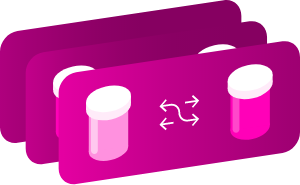Identification
- Summary
-
Dinutuximabis an immunotherapeutic agent used in combination with other immunomodulating agents to treat high-risk neuroblastoma in pediatric patients who achieve at least a partial response to prior first-line multiagent, multimodality therapy.
- Brand Names
-
Unituxin
- Generic Name
- Dinutuximab
- DrugBank Accession Number
- DB09077
- Background
-
Dinutuximab IgG1单克隆human/mouse chimeric antibody against GD2, a disialoganglioside expressed on tumors of neuroectodermal origin, including human neuroblastoma and melanoma, with highly restricted expression on normal tissues. It is composed of the variable heavy- and light-chain regions of the murine anti-GD2 mAb 14.18 and the constant regions of human IgG1 heavy-chain and kappa light-chain. By binding to GD2, dinutiximab induces antibody-dependent cell-mediated cytotoxicity and complement-dependent cytotoxicity of tumor cells thereby leading to apoptosis and inhibiting proliferation of the tumour. It is indicated, in combination with granulocyte-macrophage colony-stimulating factor (GM-CSF), interleukin-2 (IL-2), and 13-cis-retinoic acid (RA), for the treatment of pediatric patients with high-risk neuroblastoma who achieve at least a partial response to prior first-line multiagent, multimodality therapy. Despite a high clinical response seen after first-line treatment, the complete eradication of neuroblastoma is rarely achieved and the majority of patients with advanced disease suffer a relapse. Current strategies for treatment include immunotherapy with drugs such as dinutuximab to target surviving neuroblastoma cells and to prevent relapse.
- Type
- Biotech
- Groups
- Approved, Investigational
- Biologic Classification
-
Protein Based Therapies
Monoclonal antibody (mAb) - Protein Chemical Formula
- C6422H9982N1722O2008S48
- Protein Average Weight
- 145000.0 Da
- Sequences
- 不可用
- Synonyms
-
- Dinutuximab
- Dinutuximab beta
- Monoclonal antibody ch14.18
- External IDs
-
- APN-311
- APN311
- ch14.18
- ch14.18-UTC
Pharmacology
- Indication
-
Dinutuximab is indicated, in combination with granulocyte-macrophage colony-stimulating factor (GM-CSF), interleukin-2 (IL-2), and 13-cis-retinoic acid (RA), for the treatment of pediatric patients with high-risk neuroblastoma who achieve at least a partial response to prior first-line multiagent, multimodality therapy. Despite a high clinical response seen after first-line treatment, the complete eradication of neuroblastoma is rarely achieved and the majority of patients with advanced disease suffer a relapse. Current strategies for treatment include immunotherapy with drugs such as dinutuximab to target surviving neuroblastoma cells and to prevent relapse.
 Reduce drug development failure ratesBuild, train, & validate machine-learning models
Reduce drug development failure ratesBuild, train, & validate machine-learning models
with evidence-based and structured datasets.Build, train, & validate predictive machine-learning models with structured datasets. - Associated Conditions
- Contraindications & Blackbox Warnings
-
 Avoid life-threatening adverse drug eventsImprove clinical decision support with information oncontraindications & blackbox warnings, population restrictions, harmful risks, & more.Avoid life-threatening adverse drug events & improve clinical decision support.
Avoid life-threatening adverse drug eventsImprove clinical decision support with information oncontraindications & blackbox warnings, population restrictions, harmful risks, & more.Avoid life-threatening adverse drug events & improve clinical decision support. - Pharmacodynamics
-
In vitro dinutuximab binds to neuroblastoma tumour cells and mediates the lysis of tumour cells via cell-mediated and complement-mediated cytotoxicity.
- Mechanism of action
-
Dinutuximab IgG1单克隆human/mouse chimeric antibody against GD2, a disialoganglioside expressed on tumors of neuroectodermal origin, including human neuroblastoma and melanoma, with highly restricted expression on normal tissues. It is composed of the variable heavy- and light-chain regions of the murine anti-GD2 mAb 14.18 and the constant regions of human IgG1 heavy-chain and kappa light-chain. By binding to GD2, dinutiximab induces antibody-dependent cell-mediated cytotoxicity and complement-dependent cytotoxicity of tumor cells thereby leading to apoptosis and inhibiting proliferation of the tumour.
Target Actions Organism AGD2 disialoganglioside inhibitorHumans - Absorption
-
不可用
- Volume of distribution
-
The mean volume of distribution at steady state (Vdss) is 5.4 L
- Protein binding
-
不可用
- Metabolism
- 不可用
- Route of elimination
-
不可用
- Half-life
-
The terminal half-life is 10 days
- Clearance
-
The clearance is 0.21 L/day and increases with body size
- Adverse Effects
-
 Improve decision support & research outcomesWith structured adverse effects data, including:blackbox warnings, adverse reactions, warning & precautions, & incidence rates.Improve decision support & research outcomes with our structured adverse effects data.
Improve decision support & research outcomesWith structured adverse effects data, including:blackbox warnings, adverse reactions, warning & precautions, & incidence rates.Improve decision support & research outcomes with our structured adverse effects data. - Toxicity
-
The most common (incidence 15 %) grade 3 or 4 treatment-related adverse events in dinutuximab compared with standard therapy recipients were neuropathic pain (52 vs. 6 %), fever without neutropenia (39 vs. 6 %), any in-fection (39 vs. 22 %), hypokalaemia (35 vs. 2 %), hypersensitivity reactions (25 vs. 1 %), hyponatraemia (23 vs. 4 %), elevation of alanine transferase levels (23 vs. 3 %) and hypotension (18 vs. 0 %). Based on its mechanism of action, dinutuximab may cause fetal harm when administered to a pregnant woman however, there are no studies in pregnant women and no reproductive studies in animals to inform the drug-associated risk. Non-clinical studies suggest that dinutuximab-induced neuropathic pain is mediated by binding of the antibody to the GD2 antigen located on the surface of peripheral nerve fibers and myelin and subsequent induction of cell- and complement-mediated cytotoxicity. In clinical trials, 114 (85%) patients treated in the dinutuximab/RA group experienced pain despite pre-treatment with analgesics including morphine sulfate infusion. Severe (Grade 3) pain occurred in 68 (51%) patients in the dinutuximab/RA group compared to 5 (5%) patients in the RA group. Pain typically occurred during the dinutuximab infusion and was most commonly reported as abdominal pain, generalized pain, extremity pain, back pain, neuralgia, musculoskeletal chest pain, and arthralgia.
- Pathways
- 不可用
- Pharmacogenomic Effects/ADRsBrowse all" title="" id="snp-actions-info" class="drug-info-popup" href="javascript:void(0);">
- 不可用
Interactions
- Drug InteractionsLearn More" title="" id="structured-interactions-info" class="drug-info-popup" href="javascript:void(0);">
-
This information should not be interpreted without the help of a healthcare provider. If you believe you are experiencing an interaction, contact a healthcare provider immediately. The absence of an interaction does not necessarily mean no interactions exist.
Drug Interaction Integrate drug-drug
interactions in your softwareAbaloparatide The risk or severity of adverse effects can be increased when Abaloparatide is combined with Dinutuximab. Abatacept The risk or severity of adverse effects can be increased when Abatacept is combined with Dinutuximab. Abciximab The risk or severity of bleeding can be increased when Abciximab is combined with Dinutuximab. Acebutolol The risk or severity of adverse effects can be increased when Acebutolol is combined with Dinutuximab. Acenocoumarol The risk or severity of bleeding can be increased when Acenocoumarol is combined with Dinutuximab. Acetylsalicylic acid The risk or severity of bleeding can be increased when Acetylsalicylic acid is combined with Dinutuximab. Adalimumab The risk or severity of adverse effects can be increased when Adalimumab is combined with Dinutuximab. Adenovirus type 7 vaccine live The risk or severity of infection can be increased when Adenovirus type 7 vaccine live is combined with Dinutuximab. Aducanumab The risk or severity of adverse effects can be increased when Dinutuximab is combined with Aducanumab. Aldesleukin The risk or severity of adverse effects can be increased when Aldesleukin is combined with Dinutuximab.  Identify potential medication risksEasily compare up to 40 drugs with our drug interaction checker.Get severity rating, description, and management advice.Learn more
Identify potential medication risksEasily compare up to 40 drugs with our drug interaction checker.Get severity rating, description, and management advice.Learn more - Food Interactions
- No interactions found.
Products
-
 Drug product information from 10+ global regionsOur datasets provide approved product information including:
Drug product information from 10+ global regionsOur datasets provide approved product information including:
dosage, form, labeller, route of administration, and marketing period.药品信息的访问over 10 global regions. - Brand Name Prescription Products
-
Name Dosage 强度 Route Labeller Marketing Start Marketing End Region Image Qarziba Injection, solution, concentrate 4.5 mg/ml Intravenous Eusa Pharma (Netherlands) Bv 2020-12-16 Not applicable EU Unituxin Injection 3.5 mg/1mL Intravenous United Therapeutics Corporation 2015-03-10 Not applicable US Unituxin Injection, solution, concentrate 3.5 mg/ml Intravenous United Therapeutics Europe Ltd 2021-01-12 2017-04-28 EU Unituxin Solution 3.5 mg / mL Intravenous United Therapeutics Corporation 2019-05-01 Not applicable Canada
Categories
- ATC Codes
- L01FX06 — Dinutuximab beta
- Drug Categories
-
- Amino Acids, Peptides, and Proteins
- Antibodies
- Antibodies, Monoclonal
- Antineoplastic Agents
- Antineoplastic and Immunomodulating Agents
- Blood Proteins
- Cancer immunotherapy
- Globulins
- Glycolipid Disialoganglioside-directed Antibody
- Glycolipid Disialoganglioside-directed Antibody Interactions
- Hypotensive Agents
- Immunoglobulins
- Immunoproteins
- Immunosuppressive Agents
- Immunotherapy
- MONOCLONAL ANTIBODIES AND ANTIBODY DRUG CONJUGATES
- Myelosuppressive Agents
- Narrow Therapeutic Index Drugs
- Proteins
- Serum Globulins
- Chemical TaxonomyProvided byClassyfire
-
- Description
- 不可用
- Kingdom
- Organic Compounds
- Super Class
- Organic Acids
- Class
- Carboxylic Acids and Derivatives
- Sub Class
- Amino Acids, Peptides, and Analogues
- Direct Parent
- Peptides
- Alternative Parents
- 不可用
- Substituents
- 不可用
- Molecular Framework
- 不可用
- External Descriptors
- 不可用
- Affected organisms
- 不可用
Chemical Identifiers
- UNII
- 7SQY4ZUD30
- CAS number
- 1363687-32-4
References
- General References
-
- Dhillon S: Dinutuximab: first global approval. Drugs. 2015 May;75(8):923-7. doi: 10.1007/s40265-015-0399-5. [Article]
- Ahmed M, Cheung NK: Engineering anti-GD2 monoclonal antibodies for cancer immunotherapy. FEBS Lett. 2014 Jan 21;588(2):288-97. doi: 10.1016/j.febslet.2013.11.030. Epub 2013 Dec 1. [Article]
- Barker E, Mueller BM, Handgretinger R, Herter M, Yu AL, Reisfeld RA: Effect of a chimeric anti-ganglioside GD2 antibody on cell-mediated lysis of human neuroblastoma cells. Cancer Res. 1991 Jan 1;51(1):144-9. [Article]
- Aixinjueluo W, Furukawa K, Zhang Q, Hamamura K, Tokuda N, Yoshida S, Ueda R, Furukawa K: Mechanisms for the apoptosis of small cell lung cancer cells induced by anti-GD2 monoclonal antibodies: roles of anoikis. J Biol Chem. 2005 Aug 19;280(33):29828-36. Epub 2005 May 26. [Article]
- External Links
-
- KEGG Drug
- D10559
- PubChem Substance
- 347910402
- 1606274
- ChEMBL
- CHEMBL3137342
- Drugs.com
- Drugs.com Drug Page
- Wikipedia
- Dinutuximab
- FDA label
-
Download (446 KB)
Clinical Trials
- Clinical TrialsLearn More" title="" id="clinical-trials-info" class="drug-info-popup" href="javascript:void(0);">
-
Phase Status Purpose Conditions Count 4 Not Yet Recruiting Treatment Neuroblastoma (NB) 1 3 Active Not Recruiting Treatment Localized, resectable Neuroblastoma (NB)/Localized, unresectable Neuroblastoma (NB)/Recurrent Neuroblastoma/Regional Neuroblastoma/Stage 4 Neuroblastoma/Stage 4S Neuroblastoma 1 3 Completed Treatment High Risk Neuroblastoma 1 3 Recruiting Treatment High Risk Neuroblastoma 1 3 Recruiting Treatment Neuroblastoma (NB) 1 3 Unknown Status Treatment Neuroblastoma (NB) 1 2 Active Not Recruiting Treatment Ganglioneuroblastoma/High Risk Neuroblastoma 1 2 Active Not Recruiting Treatment Neuroblastoma (NB) 3 2 Completed Treatment Ganglioneuroblastoma/Recurrent Neuroblastoma 1 2 Not Yet Recruiting Treatment Childhood Osteosarcoma 1
Pharmacoeconomics
- Manufacturers
-
不可用
- Packagers
-
不可用
- Dosage Forms
-
Form Route 强度 Injection, solution, concentrate Intravenous 4.5 mg/ml Injection, solution, concentrate Intravenous; Parenteral 4.5 MG/ML Injection Intravenous 3.5 mg/1mL Injection, solution, concentrate Intravenous 3.5 MG/ML Solution Intravenous 3.5 mg / mL - Prices
- 不可用
- Patents
-
Patent Number Pediatric Extension Approved Expires (estimated) Region US20140170155 No 2014-02-18 2038-02-18 US
Properties
- State
- Solid
- Experimental Properties
- 不可用
Targets

insights and accelerate drug research.
References
- Barker E, Mueller BM, Handgretinger R, Herter M, Yu AL, Reisfeld RA: Effect of a chimeric anti-ganglioside GD2 antibody on cell-mediated lysis of human neuroblastoma cells. Cancer Res. 1991 Jan 1;51(1):144-9. [Article]
Drug created at June 18, 2015 17:47 / Updated at December 06, 2022 13:40




